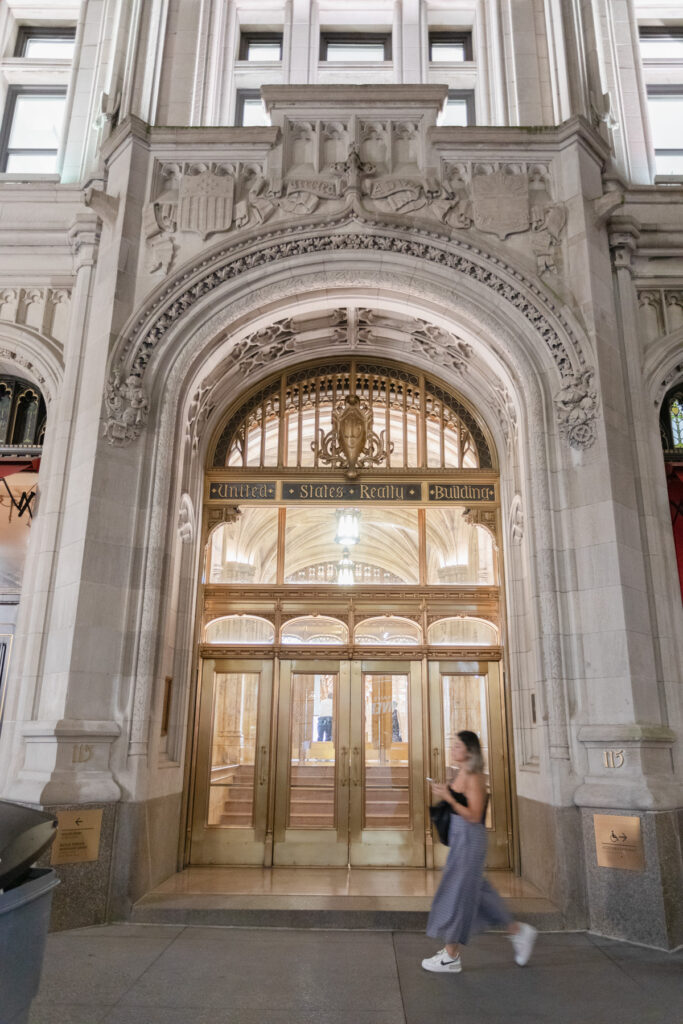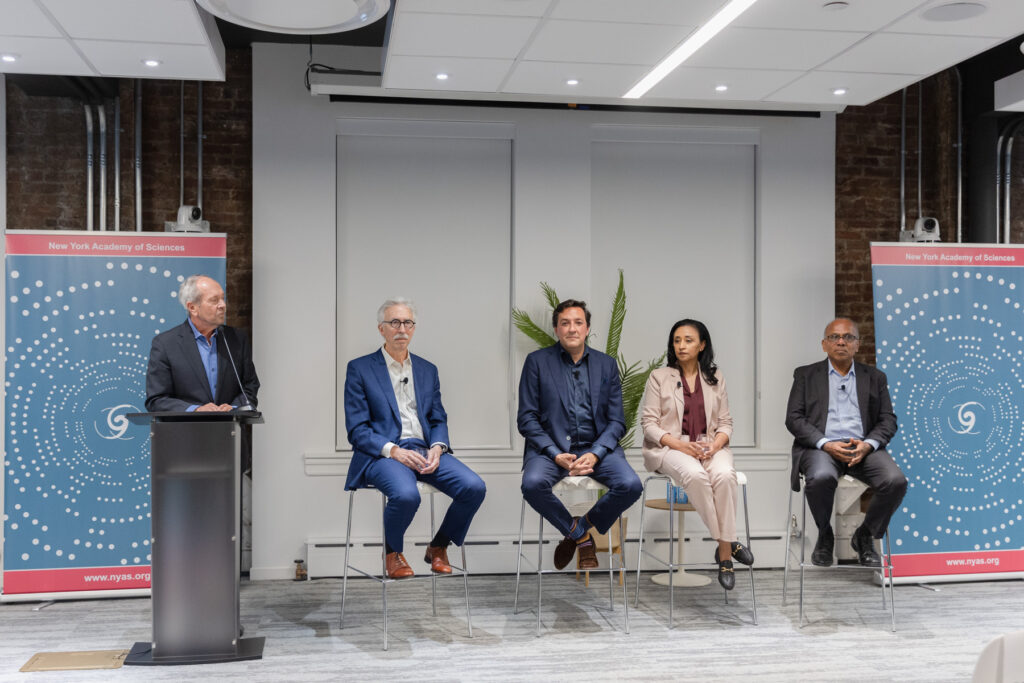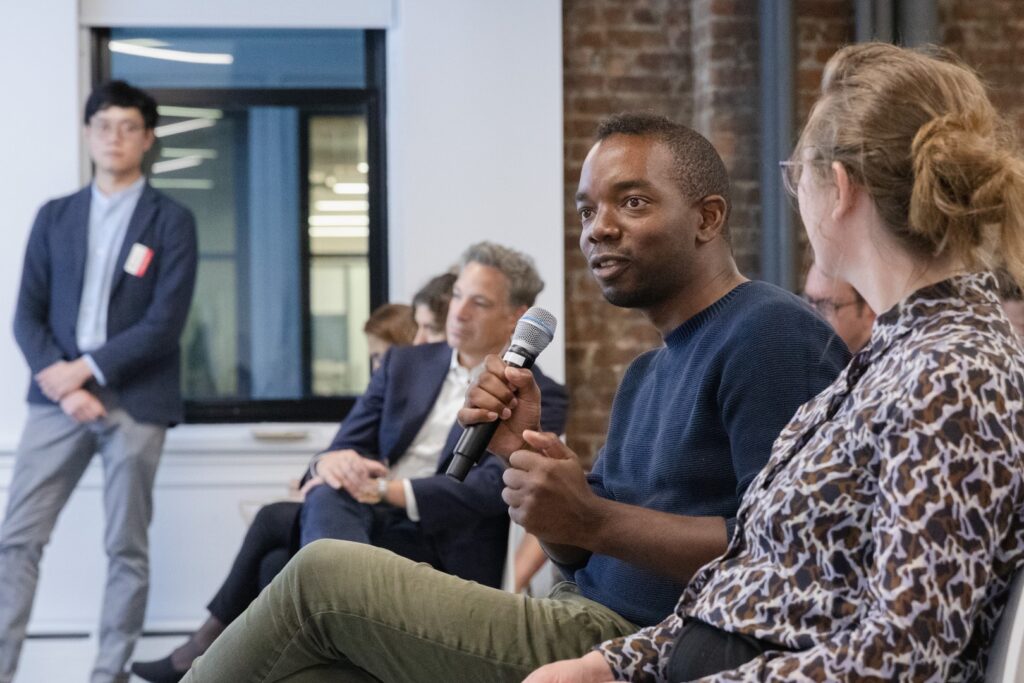The Academy Hosts Open House to Inaugurate Its New Headquarters
The Academy moved into the landmark building at 115 Broadway last May and celebrated by hosting almost 200 scientists and science enthusiasts for a special panel discussion and networking reception.

The New York Academy of Sciences inaugurated its new headquarters in Manhattan’s Financial District on September 14, 2023, with an Open House that hosted almost 200 scientists and science enthusiasts on the eighth floor of the U.S. Realty Building, a neo-Gothic skyscraper erected in 1907. The Academy moved into the landmark building at 115 Broadway last May.
The festive gathering opened a new chapter in the Academy’s 206-year history and marked the resumption of its robust program of in-person events. It featured science-themed interactive displays and idea boards on which attendees posted notes jotted in response to questions such as “What recent developments in green tech do you find most promising?” and “What do you think will be among the diseases cured by gene-editing techniques such as CRISPR Cas9?”
Attendees were also treated to a panel discussion on the future of science moderated by Nicholas B. Dirks, the Academy’s President & CEO, followed by remarks from the Chair of the Academy’s Board of Governors, Hon. Jerry Hultin.
“It’s great to have you here for the first open house,” Dirks told the audience before introducing the panelists, all members of the board. “We’ve held a few conferences here but nothing quite like this.”
Dirks asked the panelists to discuss “things that they are keeping their eyes on, both in terms of opportunities but also challenges and potential dangers.”
Advances in Quantum Computing
Darío Gil, PhD, senior vice president and director of research at IBM, predicted that a new generation of quantum computers—which perform calculations using quantum mechanical analogs of the zero and one binary digits, or bits, used by classical computers—would bring “exponential advancements” in the ability to simulate the physical world. As a result, he said, quantum computing would find wide use in chemistry, materials science, physics, and biology and “help us tackle some of the most pressing and important problems” facing humanity.
“That’s going to matter for everything from fertilizers for agriculture to new alloys for aerospace or batteries for automotive or new molecules in biology,” Dr. Gil said, adding that quantum computing would also transform encryption systems.
“We have not yet quite crossed a threshold where we can do things that are impossible to do with classical machines,” he said. “But that crossover is going to happen … it’s going to happen a hundred percent in this decade.”
Science in the Development of Vaccines

(from L) Hon. Jerry Hultin, Board Chair, The New York Academy of Sciences; Nicholas Dirks, President & CEO, The New York Academy of Sciences; Darío Gil, PhD, senior vice president and director of research at IBM; Aida Habtezion, MD, chief medical officer and head of worldwide medical & safety at Pfizer; Subra Suresh, PhD, former director of the National Science Foundation and former President of Carnegie Mellon
Aida Habtezion, MD, chief medical officer and head of worldwide medical & safety at Pfizer, detailed the key role that data science played in the rapid development of Covid vaccines. She said the confluence of artificial intelligence (AI) and machine learning, in particular, would speed the development of more new vaccines and drugs and better ensure their safety and effectiveness for large populations.
“Engineering is now actually moving into medicine, what we thought traditionally was a separate field,” Dr. Habtezion said.
Nanotechnology and Artificial Intelligence
Subra Suresh, PhD, former director of the National Science Foundation and former President of Carnegie Mellon, referenced the merging of technologies as an important trend in scientific research. He described recent experiments in which nanotechnology used in conjunction with Artificial Intelligence (AI) had given scientists key insights into altering the properties of diamond and other semiconductor materials. “No supercomputer available today can do this,” he said of the research, adding that similar work might yield new advances in microelectronics and energy storage.
Dr. Suresh made the case that AI may approach problems and conceive new inventions in ways that humans find hard to do. For example, he said, chess-playing AI has shown a willingness to sacrifice one’s queen as a route to victory—a gambit few human chess players are bold enough to try. And humans can be surprisingly slow to recognize opportunities even for simple but high-value innovations. To illustrate that point, he shared the observation that “the first patent for putting a wheel on a suitcase was filed after Neil Armstrong” set foot on the moon.
“Innovation comes in many different shades,” Dr. Suresh said. “There are sexy ones and not-so-sexy ones, and here is an example of a not-so-sexy one which is a lot more useful on a day-to-day basis for hundreds of millions of people.”

In his remarks, Jerry Hultin thanked the attendees for supporting the academy and reminded them that some of history’s greatest thinkers had been members. “We’re very proud of the fact that Thomas Jefferson, Charles Darwin, Margaret Mead all belonged to the Academy,” he said. “I think they’d be impressed tonight to know where the Academy has come to.”
Making Their New Space “Home”
Speaking after the event, Dirks said he hoped the new headquarters would become “one of the principal spaces for convening debates, deliberations, explorations into the best way to shape science going forward…My hope is that we become not only the virtual go-to space but we actually become the physical go-to space where people think ‘this is the place where I can hang out, I can interact with really interesting, smart people, I can engage in conversations that reflect the academy’s fundamental purpose.’”
The headquarters—its walls hung with science-inspired artwork on loan from artists throughout NYC laboratories and Cape Cod –occupies about 20,000 square feet, roughly half of which is set aside for events. The new offices are just a few blocks away from where the Academy was founded in 1817 at the College of Physicians and Surgeons on Barclay Street near Broadway.
The open house was made possible through the generous support of: Columbia Engineering, Kasirer, AKA Strategy, BenefitPlan Manager, EisnerAmper, and NYU.
